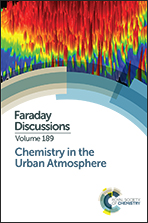The characterisation of diesel exhaust particles – composition, size distribution and partitioning
Abstract
A number of major research questions remain concerning the sources and properties of road traffic generated particulate matter. A full understanding of the composition of primary vehicle exhaust aerosol and its contribution to secondary organic aerosol (SOA) formation still remains elusive, and many uncertainties exist relating to the semi-volatile component of the particles. Semi-Volatile Organic Compounds (SVOCs) are compounds which partition directly between the gas and aerosol phases under ambient conditions. The SVOCs in engine exhaust are typically hydrocarbons in the C15–C35 range, and are largely uncharacterised because they are unresolved by traditional gas chromatography, forming a large hump in the chromatogram referred to as Unresolved Complex Mixture (UCM). In this study, thermal desorption coupled to comprehensive Two Dimensional Gas-Chromatography Time-of-Flight Mass-Spectrometry (TD-GC × GC-ToF-MS) was exploited to characterise and quantify the composition of SVOCs from the exhaust emission. Samples were collected from the exhaust of a diesel engine, sampling before and after a diesel oxidation catalyst (DOC), while testing at steady state conditions. Engine exhaust was diluted with air and collected using both filter and impaction (nano-MOUDI), to resolve total mass and size resolved mass respectively. Adsorption tubes were utilised to collect SVOCs in the gas phase and they were then analysed using thermal desorption, while particle size distribution was evaluated by sampling with a DMS500. The SVOCs were observed to contain predominantly n-alkanes, branched alkanes, alkyl-cycloalkanes, alkyl-benzenes, PAHs and various cyclic aromatics. Particle phase compounds identified were similar to those observed in engine lubricants, while vapour phase constituents were similar to those measured in fuels. Preliminary results are presented illustrating differences in the particle size distribution and SVOCs composition when collecting samples with and without a DOC. The results indicate that the DOC tested is of very limited efficiency, under the studied engine operating conditions, for removal of SVOCs, especially at the upper end of the molecular weight range.
- This article is part of the themed collection: Chemistry in the Urban Atmosphere

 Please wait while we load your content...
Please wait while we load your content...